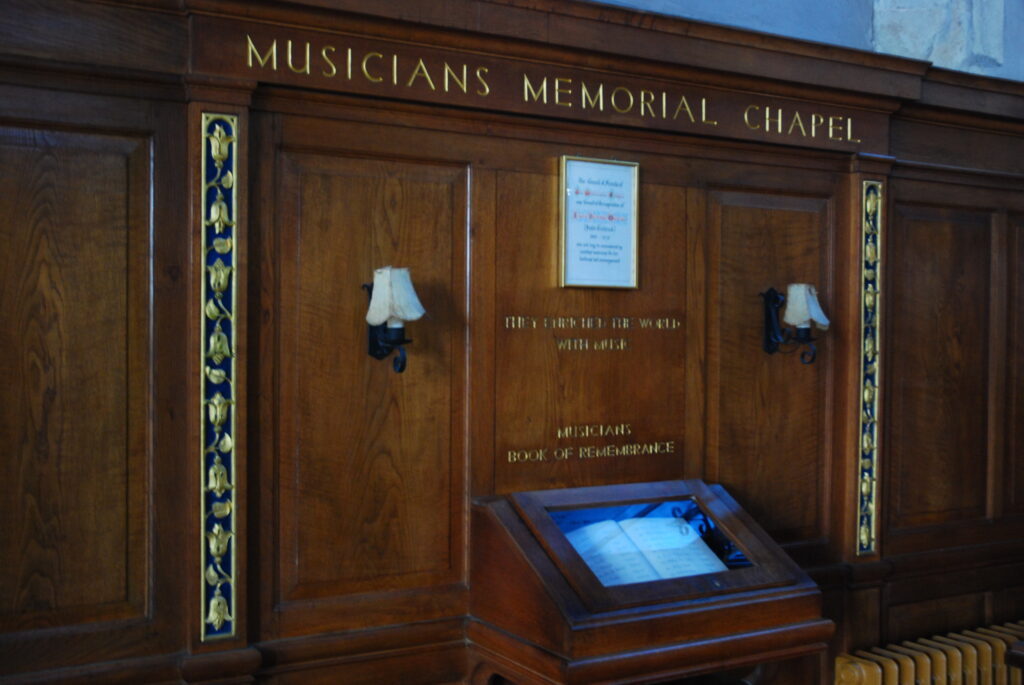History
In the Musicians’ Chapel of St. Sepulchre-without-Newgate, just opposite the Old Bailey, can be found the tomb of Sir Henry Wood alongside which has built up a host of other musical treasures.
Wood, born in 1869, was familiar with St Sepulchre’s from an early age as his father sang tenor in the choir for several years. From the age of ten he was allowed to practise on the organ, “the magnificent Renatus Harris organ in St Sepulchre’s, with its wonderful diapasons and ten stops on the pedals, filled me with wonder and admiration”. In his biography, Wood tells of the
“comic little person who used to blow for my practices…I fear I often had a little joke on him by pulling out the heavy reeds at the end of a Bach fugue. He would come rushing round – with only his trousers on – dripping with perspiration. ‘Three men’s job this mornin’, sir! Werf more’n a bob a hour!”
From the age of 14 Wood studied organ, piano and harmony with the new organist, Edwin M Lott. However, he describes how during the ‘farcical’ lessons, Lott would disappear down the nave ‘to listen’, and frequently ended up in the Viaduct Tavern next door!
Henry Wood died in August 1944, after conducting the Promenade concerts for a full fifty years. His ashes were brought to St Sepulchre’s, where his musical life had begun, and on the 14th June 1945 they were interred in St Stephen’s Chapel (later to become the Musicians’ Chapel). It is fitting that the ashes of Sir Henry Wood should rest in the church which he loved from his childhood. Beneath the beautiful window dedicated to his memory is a mural tablet which bears the inscription:
This window is dedicated to the memory of
Sir Henry Wood, C.H.,
Founder and for fifty years Conductor of
THE PROMENADE CONCERTS
1895-1944.
He opened the door to a new world
Of sense and feeling to millions of
his fellows. He gave life to Music
and he brought Music to the People.
His ashes rest beneath.
The following year, on 26th April, a memorial window, designed by Gerald E.R. Smith in collaboration with Frank Salisbury, was unveiled in St Stephen’s Chapel by the Lord Mayor of London. The service featured the choirs of St Paul’s Cathedral and Westminster Abbey, as well as the BBC Singers and BBC Chorus, supported by the London Symphony Orchestra. Lesley Woodgate conducted the BBC Chorus in William Walton’s new composition “Where does the uttered music go?”, a setting of words written especially for the occasion by Masefield. Ralph Vaughan Williams’ “Serenade to Music” was performed by an ensemble of soloists, including several who had sung in the first performance, conducted by Wood himself in 1938. In his address, the Dean of St Paul’s Cathedral said that; “from then on St Sepulchre’s would be a central shrine for music and musicians”.


On learning of Wood’s death in August 1944, the well known singer, Miss Granger Kerr, made the suggestion of a “Carnation” fund (Sir Henry Wood invariably wore a red or white carnation in his button-hole when conducting) to which admirers of the conductor might like to subscribe one or more “carnations” towards a permanent memorial such as a conductor’s rostrum in the proposed new Concert Hall, planned to succeed the Queen’s Hall which had been destroyed in the war. When the project of a new Concert Hall fell through, she decided to give the sum of £250, subscribed for this “carnation tribute” to open a fund for a Musicians’ Chapel in St Sepulchre’s Church. This fund was augmented by many other donations as well as by a collection taken at a recital given at St Sepulchre’s by Kathleen Ferrier, with Gerald Moore at the piano, on September 30th, 1952.
The dedication of the Memorial Chapel by the Dean of St Paul’s, W.R. Matthews, took place on Sunday January 2nd, 1955. It was attended by a large gathering of musicians, mostly composed of members of the Incorporated Society of Musicians who were holding their annual conference in London. The orchestra, also composed of Society members, was conducted by Sir Malcolm Sargent, whilst the BBC Singers, conducted by Leslie Woodgate, performed “The House of the Mind”, composed specially for the occasion by Herbert Howells. Recently, a newsflash film about the dedication service was discovered at St Sepulchre. This can be viewed below:
Everything in the Chapel – the chairs, furniture and over one hundred embroidered kneelers – has been given by, or in memory of, a musician. Around Henry Wood’s tomb are windows in memory of the the Australian opera singer Dame Nellie Melba and the composers Walter Carroll and John Ireland.



Against the west wall of the Chapel is the Musician’s Book of Remembrance in which are now inscribed the names of over two thousand professional musicians. “For some there be who have no memorial: who have perished as though they had never been”. Some of the most famous names in English music are recorded in the Book. But there are many whose influence on their generations was no less significant – those who “found out musical tunes”, whether as composers, performers or teachers of the art of music. The Book is now maintained by The Friends of the Musicians Chapel, who also organise an annual Commemoration service, with music provided by each of he London music colleges, in which new names are inscribed in the Book.

Holy Sepulchre London
Holy Sepulchre is the largest Parish Church in the City of London, described by Sir John Betjeman as “high, wide and handsome”.
There is no saint called “Sepulchre”. The church which stood on this site was originally dedicated to St. Edmund the Martyr – King of East Anglia. At the time of the Crusades the church was known as “St. Edmund and the Holy Sepulchre” and eventually “St. Sepulchre” – after the Holy Sepulchre of Christ in Jerusalem.
As the church of the Holy Sepulchre, the benefice was granted by Rahere, the Prior of St. Bartholomew’s, to Hagno the Clerk in 1137.
The Building
The Porch together with the tower and outer walls were built about 1450. The main body of the building was gutted by the Great Fire of London in 1666, and rebuilt in 1670-71. The present layout dates from 1875 with a re-modeled interior in 1932 by Sir Charles Nicholson. The roof and plaster ceilings were made in 1834.
“Bells of Old Bailey”
The 150 feet high tower contains a ring of twelve bells, restored in 1985, famous in the nursery rhyme as “The Bells of Old Bailey”. Most of these were made in 1739 and replaced bells brought from the Priory Church of St. Bartholomew in 1537.
The fan groining of the Porch, with its seventeen magnificently carved bosses, is the oldest part of the church and dates from about 1450.
In the North Aisle is a war memorial of the sixth Battalion City of London Rifles known as the “Cast Iron Sixth”. On the North Wall is a rough wooden cross placed on the battlefield at Loos in 1915 where one hundred officers and men perished. It was later replaced with a permanent memorial.
Martyr
One celebrated yet tragic Rector, John Rogers, was burnt at the stake in Smithfield in 1555, the first Protestant martyr of Queen Mary’s reign. He was killed for assisting William Tyndale to translate the Bible into English.
The Executioner’s Bell
In a glass case on a pillar at the south east of the nave is the Execution Bell, a grim reminder of the connection between this church and old Newgate Prison which stood, until 1902, on the site now occupied by the Central Criminal Court – “The Old Bailey”. In 1605 Robert Dowe gave fifty pounds for the ringing of the great bell on the mornings of executions, and for “other services concerning condemned prisoners” including the ringing of this hand-bell at midnight outside the condemned cell.
Royal Fusiliers’ Chapel
The south aisle contains the Regimental Chapel of the Royal Fusiliers, the City of London Regiment and now part of the Royal Regiment of Fusiliers. This chapel was dedicated in 1950. The Royal Fusiliers still hold their Remembrance Day service in this church. At the west end of the Chapel are the books of Remembrance for Fusiliers who lost their lives in the first and second world wars.
Also on the south wall is a relic of the 1450 church, a Piscina for rinsing communion vessels. This appears to be darkened by fire and is thought to still bear the traces of the Great Fire of London in 1666.
The Font
The font with its finely carved octagonal cover showing cherubs heads was presented by a parishioner in 1670, the year that the church reopened after the Great Fire. There is a second font cover in the West end of the church which came from the neighbouring parish of Christchurch Greyfriars. It was rescued by a postman from the burning church during the Blitz.
Captain John Smith
In the south aisle of the church lie the remains of Captain John Smith who died in a house nearby on 21st June 1631. The exact position of his tomb is no longer known but the brass plaque is a copy of the one which originally marked the spot. It tells us of his adventures as a soldier in Hungary where he was granted a coat of arms with “three Turks’ heads coued” after defeating three Turkish champions in single combat. But John Smith is best known for his adventures in Virginia in 1607, his rescue from death by the Princess Pocahontas and his subsequent honours as President of the Council of Virginia and Admiral of New England.
The John Smith Window
He is remembered in a handsome window designed by Francis Skeat and given by Bradford Smith in 1968. Captain Smith is shown in the central panel with his navigational instruments around his feet. The outer panels show his patrons, Robert Bertie and Samuel Saltonstall. Above are the three little ships in which the pioneers crossed the Atlantic.
The Sanctuary
Beyond the Choir is the sanctuary and high altar. The kneelers and one of the altar frontals were given in 1969 in memory of Sir Malcolm Sargent. Above is the great East Window designed by Gerald Smith in 1949 to replace one destroyed in the war. It shows Christ crucified but victorious above the City of London. Old St. Paul’s and Wren’s New St. Paul’s stand side by side with spires of City Churches, Roman Temple Tudor houses and the river flowing beneath. It shows London past and present and is a paradigm of the Holy City.
Archibald Nicholson Memorial Window
The Archibald Nicholson Memorial Window, also designed by Gerald E.R. Smith, bears the following inscription: “To the glory of God. In memory of Archibald Keightley Nicholson, Master Glass Painter, who worshipped at this church. This window is designed and carried out by the craftsmen of his studios as a thank offering for his life and friendship. 1871 – 1937.”
Archibald Nicholson’s two brothers, Charles and Sydney, also have strong links with St. Sepulchre’s Church. Sir Charles, architect and preserver of so many churches old and new, was the principal arranger and adorner of the church as it is today. Sir Sydney Nicholson was founder of the School of English Church Music (now the Royal School of Church Music) whose first London base was St. Sepulchre’s.



